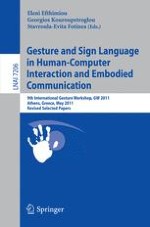2012 | Buch
Gesture and Sign Language in Human-Computer Interaction and Embodied Communication
9th International Gesture Workshop, GW 2011, Athens, Greece, May 25-27, 2011, Revised Selected Papers
herausgegeben von: Eleni Efthimiou, Georgios Kouroupetroglou, Stavroula-Evita Fotinea
Verlag: Springer Berlin Heidelberg
Buchreihe : Lecture Notes in Computer Science
